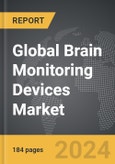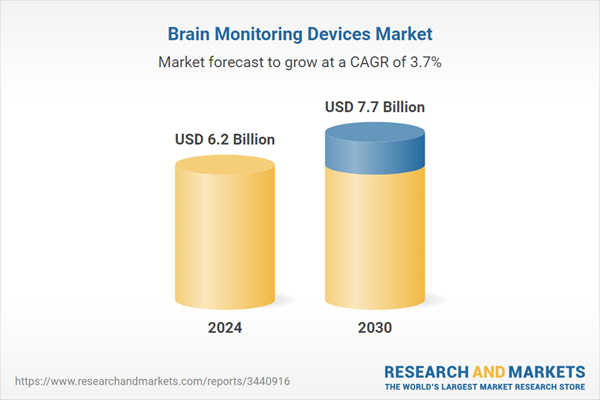The global market for Brain Monitoring Devices was valued at US$6.2 Billion in 2024 and is projected to reach US$7.7 Billion by 2030, growing at a CAGR of 3.7% from 2024 to 2030. This comprehensive report provides an in-depth analysis of market trends, drivers, and forecasts, helping you make informed business decisions. The report includes the most recent global tariff developments and how they impact the Brain Monitoring Devices market.
The advancement of sensor technology and wearable devices has significantly impacted brain monitoring by enabling continuous, non-invasive monitoring that integrates easily into daily life. These technologies, including EEG headbands and mobile health applications, facilitate real-time monitoring of brain activity and other related metrics like sleep patterns and cognition. This integration allows for constant data collection in natural settings, enhancing clinical trials and treatment strategies with a more precise and personalized approach. Moreover, the proliferation of mobile applications that offer cognitive improvement exercises and neurofeedback demonstrates the growing public and commercial recognition of the value of brain monitoring technologies. These applications not only aid in cognitive enhancement but also contribute to broader health management, reflecting an increasing trend towards integrated, user-friendly healthcare solutions.
The growth of the brain monitoring devices market is driven by several factors, including an aging global population and a corresponding increase in age-related neurological disorders such as Alzheimer's and Parkinson's. Technological advancements have refined the capabilities and accessibility of brain monitoring devices, expanding their use beyond traditional healthcare settings into user-driven health management. Support from governments and institutions for neurological research and infrastructure development further stimulates this market's growth. Additionally, rising public awareness and educational efforts about mental health issues encourage earlier diagnosis and treatment, which boosts the demand for brain monitoring devices. The integration of Artificial Intelligence enhances diagnostic precision, while telemedicine and remote monitoring trends underscore the need for devices compatible with home use, broadening the scope of brain monitoring applications. As regulatory bodies streamline approval processes and set international standards, and as global health initiatives intensify focus on neurological diseases, the market for brain monitoring devices is set to expand, reinforcing the essential role of these technologies in modern medical science and health management.
Segments: Product Type (Devices, Accessories); Disease Type (Traumatic Brain Injury, Parkinson's, Sleep Disorders, Epilepsy, Huntington's, Headache Disorders, Other Diseases); End-Use (Hospitals, Ambulatory Surgery Centers & Clinics, Neurological Centers, Diagnostic Centers, Other End-Uses).
Geographic Regions/Countries: World; United States; Canada; Japan; China; Europe (France; Germany; Italy; United Kingdom; Spain; Russia; and Rest of Europe); Asia-Pacific (Australia; India; South Korea; and Rest of Asia-Pacific); Latin America (Argentina; Brazil; Mexico; and Rest of Latin America); Middle East (Iran; Israel; Saudi Arabia; United Arab Emirates; and Rest of Middle East); and Africa.
The analysts continuously track trade developments worldwide, drawing insights from leading global economists and over 200 industry and policy institutions, including think tanks, trade organizations, and national economic advisory bodies. This intelligence is integrated into forecasting models to provide timely, data-driven analysis of emerging risks and opportunities.
Global Brain Monitoring Devices Market - Key Trends and Drivers Summarized
Brain monitoring devices are essential tools in neuroscience, helping to decipher the brain's functions and diagnose potential issues, especially as societies face aging populations and a rise in neurological disorders. These devices, which evolved from early civilizations' rudimentary practices to sophisticated imaging technologies such as MRI and fMRI, provide detailed insights into the brain's structure and activity without invasive procedures. Techniques like Electroencephalography (EEG) and Magnetoencephalography (MEG) offer high temporal and spatial resolution for tracking brain activity, critical for studying brain functions in response to various stimuli. Modern brain monitoring also emphasizes patient-centered metrics such as cognitive function and quality of life, ensuring that treatments are tailored to individual needs, which enhances the effectiveness of medical interventions for neurological conditions.The advancement of sensor technology and wearable devices has significantly impacted brain monitoring by enabling continuous, non-invasive monitoring that integrates easily into daily life. These technologies, including EEG headbands and mobile health applications, facilitate real-time monitoring of brain activity and other related metrics like sleep patterns and cognition. This integration allows for constant data collection in natural settings, enhancing clinical trials and treatment strategies with a more precise and personalized approach. Moreover, the proliferation of mobile applications that offer cognitive improvement exercises and neurofeedback demonstrates the growing public and commercial recognition of the value of brain monitoring technologies. These applications not only aid in cognitive enhancement but also contribute to broader health management, reflecting an increasing trend towards integrated, user-friendly healthcare solutions.
The growth of the brain monitoring devices market is driven by several factors, including an aging global population and a corresponding increase in age-related neurological disorders such as Alzheimer's and Parkinson's. Technological advancements have refined the capabilities and accessibility of brain monitoring devices, expanding their use beyond traditional healthcare settings into user-driven health management. Support from governments and institutions for neurological research and infrastructure development further stimulates this market's growth. Additionally, rising public awareness and educational efforts about mental health issues encourage earlier diagnosis and treatment, which boosts the demand for brain monitoring devices. The integration of Artificial Intelligence enhances diagnostic precision, while telemedicine and remote monitoring trends underscore the need for devices compatible with home use, broadening the scope of brain monitoring applications. As regulatory bodies streamline approval processes and set international standards, and as global health initiatives intensify focus on neurological diseases, the market for brain monitoring devices is set to expand, reinforcing the essential role of these technologies in modern medical science and health management.
Report Scope
The report analyzes the Brain Monitoring Devices market, presented in terms of units. The analysis covers the key segments and geographic regions outlined below.Segments: Product Type (Devices, Accessories); Disease Type (Traumatic Brain Injury, Parkinson's, Sleep Disorders, Epilepsy, Huntington's, Headache Disorders, Other Diseases); End-Use (Hospitals, Ambulatory Surgery Centers & Clinics, Neurological Centers, Diagnostic Centers, Other End-Uses).
Geographic Regions/Countries: World; United States; Canada; Japan; China; Europe (France; Germany; Italy; United Kingdom; Spain; Russia; and Rest of Europe); Asia-Pacific (Australia; India; South Korea; and Rest of Asia-Pacific); Latin America (Argentina; Brazil; Mexico; and Rest of Latin America); Middle East (Iran; Israel; Saudi Arabia; United Arab Emirates; and Rest of Middle East); and Africa.
Key Insights:
- Market Growth: Understand the significant growth trajectory of the Devices segment, which is expected to reach US$5.8 Billion by 2030 with a CAGR of a 3.8%. The Accessories segment is also set to grow at 3.3% CAGR over the analysis period.
- Regional Analysis: Gain insights into the U.S. market, valued at $1.6 Billion in 2024, and China, forecasted to grow at an impressive 6.4% CAGR to reach $1.6 Billion by 2030. Discover growth trends in other key regions, including Japan, Canada, Germany, and the Asia-Pacific.
Why You Should Buy This Report:
- Detailed Market Analysis: Access a thorough analysis of the Global Brain Monitoring Devices Market, covering all major geographic regions and market segments.
- Competitive Insights: Get an overview of the competitive landscape, including the market presence of major players across different geographies.
- Future Trends and Drivers: Understand the key trends and drivers shaping the future of the Global Brain Monitoring Devices Market.
- Actionable Insights: Benefit from actionable insights that can help you identify new revenue opportunities and make strategic business decisions.
Key Questions Answered:
- How is the Global Brain Monitoring Devices Market expected to evolve by 2030?
- What are the main drivers and restraints affecting the market?
- Which market segments will grow the most over the forecast period?
- How will market shares for different regions and segments change by 2030?
- Who are the leading players in the market, and what are their prospects?
Report Features:
- Comprehensive Market Data: Independent analysis of annual sales and market forecasts in US$ Million from 2024 to 2030.
- In-Depth Regional Analysis: Detailed insights into key markets, including the U.S., China, Japan, Canada, Europe, Asia-Pacific, Latin America, Middle East, and Africa.
- Company Profiles: Coverage of players such as Advanced Brain Monitoring Inc., Cadwell Laboratories Inc., CAS Medical Systems, Compumedics Germany GmbH, Compumedics Ltd. and more.
- Complimentary Updates: Receive free report updates for one year to keep you informed of the latest market developments.
Some of the 23 companies featured in this Brain Monitoring Devices market report include:
- Advanced Brain Monitoring Inc.
- Cadwell Laboratories Inc.
- CAS Medical Systems
- Compumedics Germany GmbH
- Compumedics Ltd.
- Electrical Geodesics Inc.
- Elekta AB
- HeadSense Medical Inc.
- Integra Life Sciences Corporation
- Masimo Corporation
- Medtronic Plc.
- Natus Medical Inc.
- NeuroWave Systems Inc.
- Nihon Kohden Corporation
- Nonin Medical, Inc.
- Ornim Medical
- Raumedic AG
- Rimed Inc.
- Spiegelberg GmbH
- Third Eye Diagnostics Inc.
Tariff Impact Analysis: Key Insights for 2025
Global tariff negotiations across 180+ countries are reshaping supply chains, costs, and competitiveness. This report reflects the latest developments as of April 2025 and incorporates forward-looking insights into the market outlook.The analysts continuously track trade developments worldwide, drawing insights from leading global economists and over 200 industry and policy institutions, including think tanks, trade organizations, and national economic advisory bodies. This intelligence is integrated into forecasting models to provide timely, data-driven analysis of emerging risks and opportunities.
What’s Included in This Edition:
- Tariff-adjusted market forecasts by region and segment
- Analysis of cost and supply chain implications by sourcing and trade exposure
- Strategic insights into geographic shifts
Buyers receive a free July 2025 update with:
- Finalized tariff impacts and new trade agreement effects
- Updated projections reflecting global sourcing and cost shifts
- Expanded country-specific coverage across the industry
Table of Contents
I. METHODOLOGYII. EXECUTIVE SUMMARY2. FOCUS ON SELECT PLAYERSIII. MARKET ANALYSISCANADAITALYSPAINRUSSIAREST OF EUROPESOUTH KOREAREST OF ASIA-PACIFICARGENTINABRAZILMEXICOREST OF LATIN AMERICAIRANISRAELSAUDI ARABIAUNITED ARAB EMIRATESREST OF MIDDLE EASTIV. COMPETITION
1. MARKET OVERVIEW
3. MARKET TRENDS & DRIVERS
4. GLOBAL MARKET PERSPECTIVE
UNITED STATES
JAPAN
CHINA
EUROPE
FRANCE
GERMANY
UNITED KINGDOM
ASIA-PACIFIC
AUSTRALIA
INDIA
LATIN AMERICA
MIDDLE EAST
AFRICA
Companies Mentioned (Partial List)
A selection of companies mentioned in this report includes, but is not limited to:
- Advanced Brain Monitoring Inc.
- Cadwell Laboratories Inc.
- CAS Medical Systems
- Compumedics Germany GmbH
- Compumedics Ltd.
- Electrical Geodesics Inc.
- Elekta AB
- HeadSense Medical Inc.
- Integra Life Sciences Corporation
- Masimo Corporation
- Medtronic Plc.
- Natus Medical Inc.
- NeuroWave Systems Inc.
- Nihon Kohden Corporation
- Nonin Medical, Inc.
- Ornim Medical
- Raumedic AG
- Rimed Inc.
- Spiegelberg GmbH
- Third Eye Diagnostics Inc.
Table Information
| Report Attribute | Details |
|---|---|
| No. of Pages | 184 |
| Published | April 2025 |
| Forecast Period | 2024 - 2030 |
| Estimated Market Value ( USD | $ 6.2 Billion |
| Forecasted Market Value ( USD | $ 7.7 Billion |
| Compound Annual Growth Rate | 3.7% |
| Regions Covered | Global |









